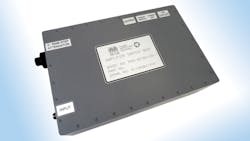Model PSD-6G16G-CD-1 is a high-power switch assembly that that can protect sensitive components and systems (such as receivers) when in the presence of high-power signals. It does this by sensing input signal levels and switching input signals to 50-Ω terminations when a threshold level has been exceeded. The switch assembly is designed for power levels as high as 10 W continuous wave (CW) across a frequency range of 6 to 18 GHz. It is supplied with an external step attenuator with range of 0 to 69 dB to adjust signal levels for the threshold setting (and therefore the trigger level for the switch assembly). The assembly achieves switching speed of 50 ns maximum and operates on 110 VAC. It is supplied in a housing measuring 15.0 x 10.0 x 4.0 in. and is shielded for electromagnetic interference (EMI) and designed for harsh environments.
Planar Monolithics Industries, Inc., 7311-F Grove Rd., Frederick, MD 21710; (301) 662-5019, FAX: (301) 662-1731, e-mail: [email protected], www.pmi-rf.com.
About the Author
Jack Browne
Technical Contributor
Jack Browne, Technical Contributor, has worked in technical publishing for over 30 years. He managed the content and production of three technical journals while at the American Institute of Physics, including Medical Physics and the Journal of Vacuum Science & Technology. He has been a Publisher and Editor for Penton Media, started the firm’s Wireless Symposium & Exhibition trade show in 1993, and currently serves as Technical Contributor for that company's Microwaves & RF magazine. Browne, who holds a BS in Mathematics from City College of New York and BA degrees in English and Philosophy from Fordham University, is a member of the IEEE.
